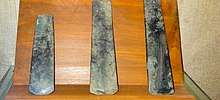Barli Inscription
The Barli Inscription (obtained from a Bhinaika village 36 miles southeast of Ajmer)[1] belonging perhaps to 5th-4th century B.C. is one of the earliest Jaina[2] inscriptions reported from Rajasthan.[3]
| Barli Inscription | |
|---|---|
 Barli Inscription excavated in Rajasthan | |
| Material | Stone |
| Size | 13x10 inches |
| Writing | Prakrit language |
| Period/culture | 443, 374-373 or 1st century BCE |
| Discovered | 26°18′48.3″N 72°55′51.6″E |
| Discovered by | G. H. Ojha |
| Place | Ajmer District, Rajasthan |
| Present location | Rājputānā Government Museum, Ajmer |
History
Earlier scholars assigned the Barli inscription to the pre-Ashoka period, but more recent scholars have assigned it to a later date.[4]
According to historian G. H. Ojha, who discovered the inscription in 1912, the inscription contains the line Viraya Bhagavate chaturasiti vase, which can be interpreted as "dedicated to Lord Vira in his 84th year".[5] Based on this reading, Ojha concluded that the record was inscribed in 443 BCE means 84 Years after the Nirvana of Tirthankara Mahavira.[6] Vira is one of the epithets of 24th Tirthankara Mahavira.
K. P. Jayaswal also agreed with Ojha's reading.[7][8][9] Indian Magazine Editor Ramananda Chatterjee has assigned the inscription to 4th Century BC.[10] On Paleographic grounds, the inscription can be assigned to the 2nd-1st century BCE.[11]
Historians such as D. C. Sircar has stated that word "Bhagavata" in the inscription may also refers to the first century BCE Shunga king Bhagabhadra which may also contradict the fact that Shunga Dynasty did not have any traces in Rajasthan.[12][13]
Description
This inscription is present on a piece of the pillar of dimension 13x10 inches. The inscription is written in Prakrit language. The writing was done by engraving, sewing, engraving, weaving, digging, piercing, burning, and punching. There are many defects in this inscriptions.[14]
See also
References
Citation
- Sircar, Dineschandra (1971). Studies in the Geography of Ancient and Medieval India. Motilal Banarsidass Publ. ISBN 978-81-208-0690-0.
- "Jaina Bibliography : Jain, Chhote Lal : Free Download, Borrow, and Streaming". Internet Archive. Retrieved 2020-08-15.
- "barli jain - Google Search". www.google.co.in. Retrieved 2020-08-14.
- Dilip K. Chakrabarty 2009, pp. 355–356.
- Dwivedi, Bhanwar Lal (1994). Evolution of educational thought in India. Northern Book Centre. ISBN 978-81-7211-059-8.
- Goyal 2006, p. 105.
- S. R. Goyal 2005, p. 22.
- Jain 1972, p. 152.
- Institute, Bhandarkar Oriental Research (1978). Annals of the Bhandarkar Oriental Research Institute.
- Chatterjee, Ramananda (1958). The Modern Review. Prabasi Press Private, Limited.
- Swarajya Prakash Gupta & K. S. Ramachandran 1979, p. 106:"The Barli inscription, which was placed by Ojha in fifth century B.C., can really be assigned to the first century B.C., on paleographic grounds."
- Meena, R. P. RPSC RAS Prelims: History of Rajasthan Complete Study Notes With MCQ. New Era Publication.
- Krishna Gopal Sharma 1993, pp. 5-8.
- Dwivedi 1994, p. 101.
Sources
- Muni, Nagraj (1986), Agama Aura Tripitaka: Eka Anusilana, Concept Publishing Company, ISBN 9788170227311
- Dwivedi, Bhanwar Lal (1994), Evolution of educational thought in India, Northern Book Centre, ISBN 9788172110598
- Dilip K. Chakrabarty (2009). India: An Archaeological History: Palaeolithic Beginnings to Early Historic Foundations. Oxford University Press India. p. 356. ISBN 978-0-19-908814-0.CS1 maint: ref=harv (link)
- Krishna Gopal Sharma (1993). Early Jaina inscriptions of Rajasthan. Navrang. ISBN 978-81-7013-081-9.CS1 maint: ref=harv (link)
- S. R. Goyal (2005). Ancient Indian Inscriptions: Recent Finds and New Interpretations. Kusumanjali Book World.CS1 maint: ref=harv (link)
- Goyal, S. R. (2006), Brāhmī Script: An Invention of the Early Maurya Period, Kusumanjali Book World
- Swarajya Prakash Gupta; K. S. Ramachandran, eds. (1979). The Origin of Brahmi script. D.K. p. 106.
- Jain, Kailash Chand (1972), Malwa Through The Ages, Motilal Banarsidass Publ., ISBN 978-81-208-0824-9